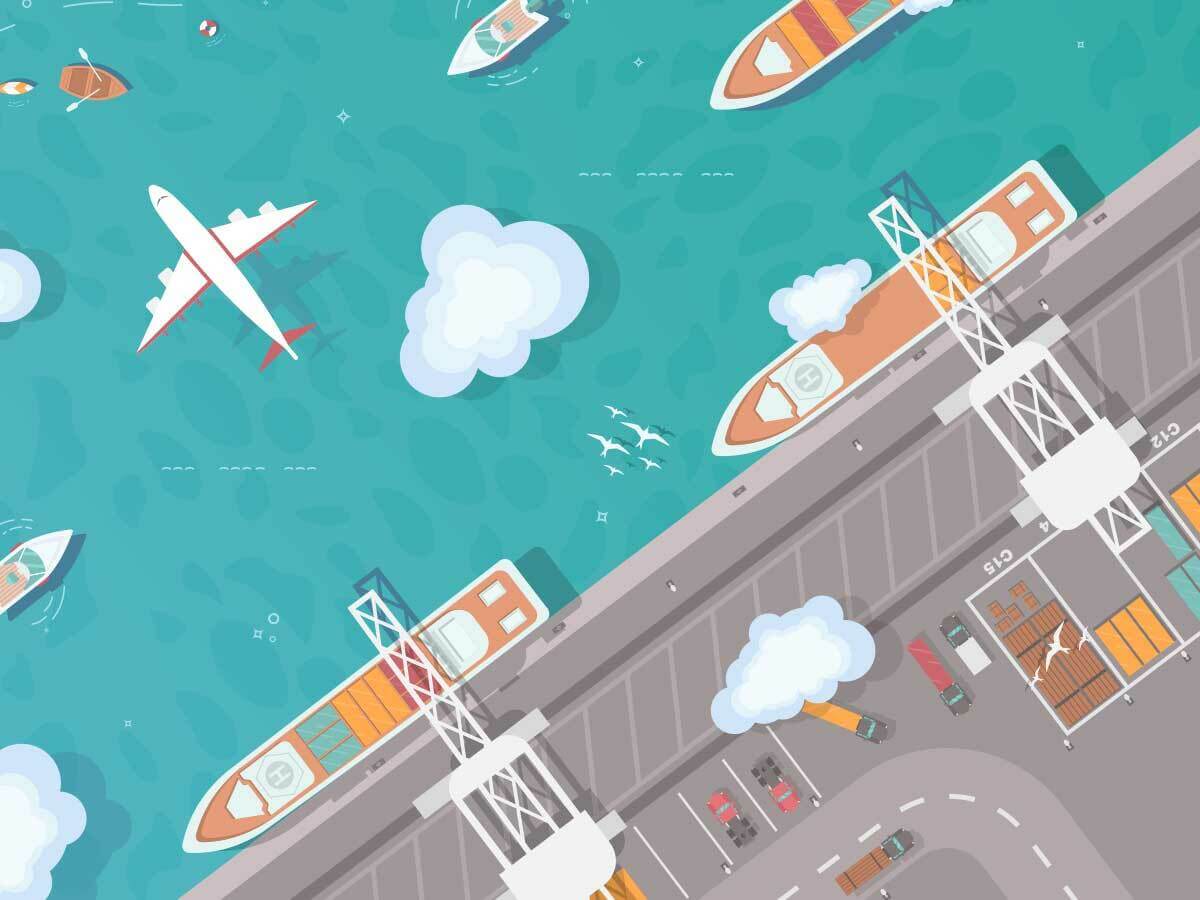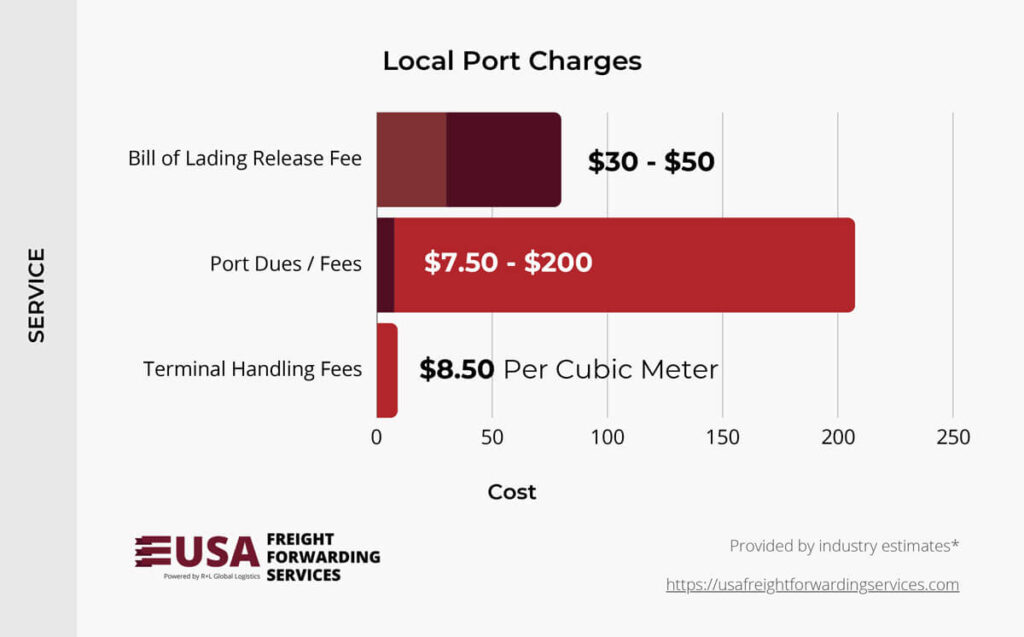
Port to port shipping is a service that’s commonly used by business moving cargo overseas. Despite its unique features, there are some key components to this service you should know.
Key takeaways:
Fortunately for you, USA Freight Forwarding has 30+ years of experience and we’re going to use it to help you better understand port to port shipping services.
Port to port shipping is a service that’s used to transport cargo between one port to another. PTP is a limited service because it doesn’t include transport of containers to and from a port.
Before using PTP, you should be familiar with the various costs that come with it. There are a few components that make this service work, despite its limited nature.
Costs you can expect include:
Vessel transport is a key component of PTP services. Therefore, an ocean freight rate has to be calculated to determine the cost to move your container between locations.
Ocean ports charge security fees, which are used to cover the cost of maintaining and implementing safety measures within these facilities. As a result, your cargo will be well protected.
You’ll have to rent a container to move your cargo across the sea. The fee for renting one will vary based on different factors.
If you’re the consignee using this service, you’ll have a limited amount of time to move your container out of the port. This is also known as free time. You’ll be charged additional fees if your container doesn’t leave within this allotted period.
Another service that comes with port to port shipping is cargo tracking. This is a must-have service when transporting goods overseas. You’ll be able to keep tabs on your shipment and communicate its arrival with the buyer.
If a freight forwarder is helping you with PTP, they’ll be able to obtain and fill out all the essential documents that are applicable to your shipment. That said, some of these documents might cost additional fees to obtain.

Focusing on port to port transportation has some unique benefits that make it a perfect option when used by experienced shippers. We’re going to discuss each one to show you why this service is appealing.
Port to port shipping is a cheap way to transport freight internationally. This service will only charge you the cost of moving goods by vessel.
Door-to-door is more expensive because it includes inland and ocean transportation on both sides. The limited scope of PTP services can help you save on costs in the long run.
However, savings vary greatly based on your agreements with the seller. It’s also necessary to account for pre-carriage and post-carriage shipping.
Port to port shipping is a less risky way of transporting cargo because of reduced handling. Containers and the cargo inside of them are always at risk of damage when they’re manipulated.
Fortunately, freight that’s moved with PTP shipping won’t be handled very much. Since this service only takes cargo between facilities, you won’t have to worry about it being transferred between different methods of transport.
Provided that your only concern with the cargo is the ocean passage, that clears you of fault for damage that might be incurred further along in the shipping process.
PTP shipping is also better for security purposes. While the quality of infrastructure can vary between ports, most of them have high levels of security. Containers that house international cargo add extra theft protection to shipments.
With these measures in place, it will be more difficult for your freight to be stolen when it’s secured at a port.
Incoterms® are often used by buyers and sellers to better understand each other’s responsibilities when conducting international transactions. Of the 11 different terms, there are a select few that are best for port to port shipments.
These include:
The CIF and CFR Incoterms® can only be used for overseas shipping, which makes them perfect for PTP services. Both terms evenly split the responsibilities between sellers and buyers as their cargo travels from one port to another.
Under CIF, you’ll only need to pay the costs for insurance and transportation of the cargo. You’ll only need to pay the cost to ship the freight when using CFR. Risk is transferred to the buyer once the goods have been loaded inside the ship.
If you are the consignee receiving the goods in this situation, you save yourself the money it takes to get it onto the ship. However, with both CIF and CFR, you’ll need to make arrangements for post-carriage.
This would need to be a separate contract from that made with the buyer, and the reason this service is typically used only by experienced shippers. It requires significant experience and knowledge of domestic logistics.
Door-to-door shipping is a more comprehensive way of shipping freight than port to port. With this service, cargo starts at the seller’s warehouse and is transported directly to the buyer of the products, usually by a single entity organizing all the movement.
Port to port services focuses primarily on ocean transportation. End-to-end shipping utilizes rail, truck, and vessel modes of shipping to deliver goods to the final destination.
This method of shipping freight across the world is more expensive than PTP because of the different modes of transport that are implemented. The price of end-to-end services though does bring enhanced stability to the supply chain.
Coordination by a single provider, typically a freight broker, means that the risk of miscommunication between parties is reduced, and it allows costs to be consolidated. Not to mention, those using it tend to gain a little more piece of mind.
Learn about the types of ocean freight forwarding services to find the one perfect for your needs.
PTP services are a great way to move freight across the world. That said, there are numerous factors that can impact its efficiency. You’ll also need to consider how your freight will be transported before it’s loaded at the port of origin and unloaded at the port of destination.
Port schedules announce the arrival and departure times of different vessels. Since PTP services don’t account for inland transportation to a port, you’ll need to keep track of the schedule to make sure your container is present and loaded before your vessel departs.
Schedules vary based on the carrier and their availability. This can impact the speed of your shipment’s transit times just as much as distance can. Therefore, it’s important you review the port schedules of different carriers before using PTP services.
Transit times for port to port services can be anywhere between 10 and 60 days. These time frames can vary based on origin and destination, weather, and shipping lane.
This service only accounts for transportation between the port of origin and the port of destination. As mentioned, you will still need to account for pre-carriage and post-carriage.
The extent of your involvement will depend on the Incoterms® you agreed to and what your role is within the shipping process as a whole.
Although cargo insurance isn’t mandatory, it’s one of the best ways to protect yourself from potential losses and damages your freight might suffer. Most carriers offer insurance that’s called carrier liability.
Unfortunately, this form of coverage is very limited and favors the carrier over the shipper. You should obtain a separate cargo insurance policy to better protect yourself.
Two popular polices you can choose from include:
Named perils will protect you from specific risks that you name, while all-risk will give you a comprehensive level of protection from a variety of dangers.
The local charges at the ports your cargo will be traveling to and from are another factor to consider. PTP shipping only accounts for specific services, which means you’ll have to account for anything additional.
Local charges can include:
We’ve provided some data on how much these unique expenses might cost.

Being prepared to pay for these services will help you avoid any unexpected expenses when using PTP shipping.
Port to port shipping is great for businesses that already have the knowledge and expertise to handle other parts of the international transportation more conveniently.
Companies like these have a logistics system in place that allows them to move containers in and out of the port. However, less experienced businesses won’t enjoy the same benefits because they have to account for other factors of shipping.
If your business doesn’t have logistical resources to handle pre-carriage and post-carriage, then port to port shipping might not be the best for you. That doesn’t mean your ocean shipment isn’t doomed to failure.
At USA Freight Forwarding, we use our 30+ years of experience in the industry to bring success to every shipment we handle. You’ll never feel left without help when you have our team guiding you through the entire international ocean shipping process.
Three services we offer that you can take advantage of include:
Improve your international shipping operations by picking USA Freight Forwarding. You can start today by contacting us through the site. Our team can also be reached at (866) 941-8081 if you have any further questions about how we can help.
